|
||||||||||
|
|
||||||||||
|
||||||||||
|
|
||||||||||
The first topic we need to address is establishing some basic definitions. Missiles can be categorized in many different ways, such as by their mission or lauch platform. The two conventions we will follow in this article concern the missile's type of guidance and type of sensor or seeker. These two concepts are often used interchangeably, but it is important to understand their differences.

Missile guidance concerns the method by which the missile receives its commands to move along a certain path to reach a target. On some missiles, these commands are generated internally by the missile computer autopilot. On others, the commands are transmitted to the missile by some external source. The missile sensor or seeker, on the other hand, is a component within a missile that generates data fed into the missile computer. This data is processed by the computer and used to generate guidance commands. Sensor types commonly used today include infrared, radar, and the global positioning system. Based on the relative position between the missile and the target at any given point in flight, the computer autopilot sends commands to the control surfaces to adjust the missile's course.
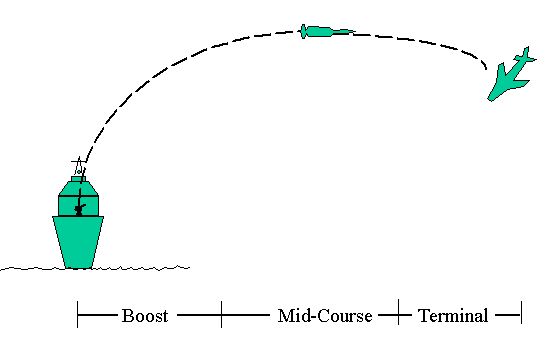
In many missiles, the guidance system is divided into three phases, as pictured above. The first is a launch or boost phase in which the guidance system is usually disabled to allow the missile to safely travel away from the launch platform. The majority of the flight is flown using midcourse guidance, during which the missile makes slight adjustments to its trajectory allowing it to reach the vicinity of the target. The final phase is terminal guidance when the missile uses a highly accurate tracking system to make rapid maneuvers for intercepting the target. Many missiles use a different type of guidance in the midcourse phase than in the terminal phase, as will be discussed later.
The primary forms of missile guidance are described below with examples of missiles and seekers used to accomplish that type of guidance.
Beam Rider Guidance
The beam rider concept relies on an external ground- or ship-based radar station that transmits a beam of radar energy towards the target. The surface radar tracks the target and also transmits a guidance beam that adjusts its angle as the target moves across the sky.
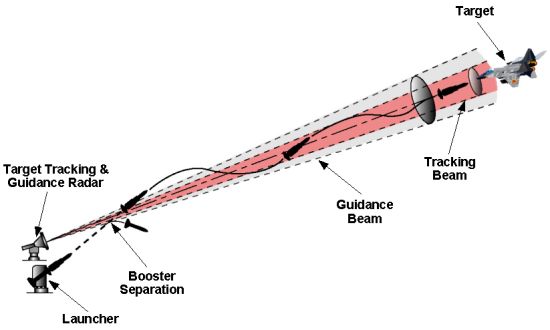
The missile is launched into this guidance beam and uses it for direction. Scanning systems onboard the missile detect the presence of the beam and determine how close the missile is to the edges of it. This information is used to send command signals to control surfaces to keep the missile within the beam. In this way, the missile "rides" the external radar beam to the target.
Beam riding was often used on early surface-to-air missiles but was found to become inaccurate at long ranges. Limited improvement was possible using two different surface-based radar beams, but the beam rider method has been largely abandoned. The technique was used on the US Navy's Terrier ship-launched surface-to-air missile of the 1950s.
Command Guidance
Command guidance is similar to beam riding in that the target is tracked by an external radar. However, a second radar also tracks the missile itself. The tracking data from both radars are fed into a ground based computer that calculates the paths of the two vehicles.

This computer also determines what commands need to be sent to the missile control surfaces to steer the missile on an intercept course with the target. These commands are transmitted to a receiver on the missile allowing the missile to adjust its course. An example of command guidance is the Russian SA-2 surface-to-air missile used against US aircraft in North Vietnam.
Also note that command guidance is not limited just to radar. Another method that falls under command guidance is the use of wire guided systems. In this technique, commands are sent to the missile through a conventional wire or fiber optic cable that reels out from the missile back to its launcher. Wire guidance is often used on anti-tank missiles like TOW, which can be launched from both ground vehicles and helicopters. Many naval torpedoes fired from submarines also use wire guidance.
HOMING GUIDANCE
Homing guidance is the most common form of guidance used in anti-air missiles today. Three primary forms of guidance fall under the homing guidance umbrella--semi active, active, and passive. We will discuss each of these in turn, as well as a more unusual form called retransmission or track-via-missile homing.
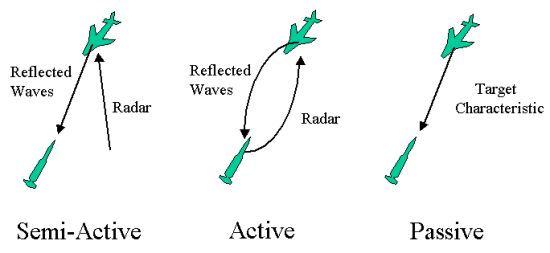
Semi-Active Homing Guidance
A semi-active system is similar to command guidance since the missile relies on an external source to illuminate the target. The energy reflected by this target is intercepted by a receiver on the missile. The difference between command guidance and semi-active homing is that the missile has an onboard computer in this case. The computer uses the energy collected by its radar receiver to determine the target's relative trajectory and send correcting commands to control surfaces so that the missile will intercept the target.

The example shown above illustrates the guidance method used on an air-to-air missile like Sparrow. This missile relies on radar energy transmitted by the launch aircraft to track and home in on the target. This system is also sometimes referred to as bistatic meaning that the radar waves that intercept the target and those reflected back to the missile are at different angles to one another.
However, it should be noted that semi-active guidance is used by other types of seekers besides radar. Laser-guided weapons like the Paveway series can also be considered semi-active weapons because the laser energy these bombs track as they steer towards a target is supplied by an external source. The source could be a laser designation pod on the launch aircraft, on a second aircraft, or aimed by a soldier on the ground.
Active Homing Guidance
Active homing works just like semi-active except that the tracking energy is now both transmitted by and received by the missile itself. No external source is needed. It is for this reason that active homing missiles are often called "fire-and-forget" because the launch aircraft does not need to continue illuminating the target after the missile is launched.

Active homing missiles typically use radar seekers to track their target. These seekers are also sometimes called monostatic because, unlike semi-active guidance, the transmitted and reflected waves are at the same angle with respect to the line of sight between the missile and target. Examples of active homing missiles include the AMRAAM air-to-air and Exocet anti-ship missiles.
Passive Homing Guidance
A passive homing system is like active in that the missile is independent of any external guidance system and like semi-active in that it only receives signals and cannot transmit. Passive missiles instead rely on some form of energy that is transmitted by the target and can be tracked by the missile seeker.
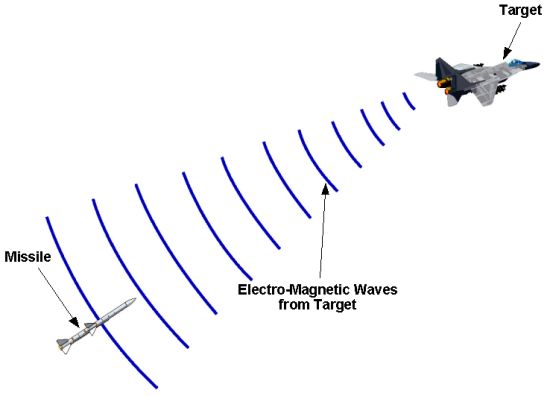
This energy could take many forms. For example, infrared seekers like those used on Sidewinder home in on the heat signature generated by a target. Anti-radiation missiles like HARM track the radio frequency energy transmitted by ground-based radar stations. Passive torpedoes use sonar, or sound waves, created by the engines of ships to attack their targets. Electro-optic sensors like those used on Maverick rely on visual images to guide towards a target.
Retransmission Homing Guidance
A more unusual example of homing guidance is the retransmission method. This technique is largely similar to command guidance but with a unique twist. The target is tracked via an external radar, but the reflected signal is intercepted by a receiver onboard the missile, as in semi-active homing. However, the missile has no onboard computer to process these signals. The signals are instead transmitted back to the launch platform for processing. The subsequent commands are then retransmitted back to the missile so that it can deflect control surfaces to adjust its trajectory.
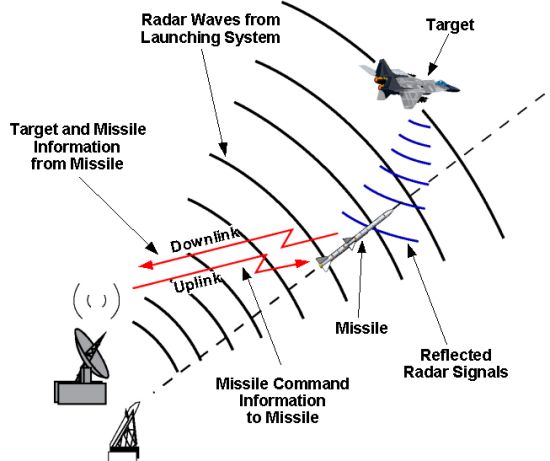
This method is also sometimes called "track via missile" (TVM) since the missile acts as a conduit of tracking information from the target back to the ground control station. The advantage of TVM homing is that most of the expensive tracking and processing hardware is located on the ground where it can be reused for future missile launches rather than be destroyed. Unfortunately, the method also requires excellent high-speed communication links between the missile and control station, limiting the system to rather short ranges. Retransmission homing guidance is used on the Patriot surface-to-air missile.
NAVIGATION GUIDANCE
Like homing guidance, navigation guidance includes several subcategories. In this section, we will describe inertial, ranging, celestial, and geophysical navigation techniques.
Inertial Navigation Guidance
Inertial navigation relies on devices onboard the missile that sense its motion and acceleration in different directions. These devices are called gyroscopes and accelerometers.

The purpose of a gyroscope is to measure angular rotation, and a number of different methods to do so have been devised. A classic mechanical gyroscope senses the stability of a mass rotating on gimbals. More recent ring laser gyros and fiber optic gyros are based on the interference between laser beams. Current advances in Micro-Electro-Mechanical Systems (MEMS) offer the potential to develop gyroscopes that are very small and inexpensive.
While gyroscopes measure angular motion, accelerometers measure linear motion. The accelerations from these devices are translated into electrical signals for processing by the missile computer autopilot. When a gyroscope and an accelerometer are combined into a single device along with a control mechanism, it is called an inertial measurement unit (IMU) or inertial navigation system (INS).
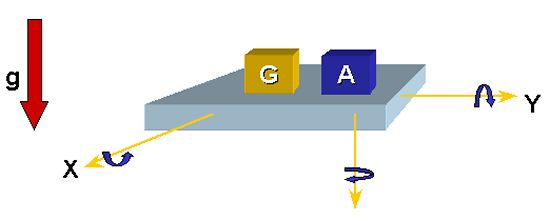
The INS uses these two devices to sense motion relative to a point of origin. Inertial navigation works by telling the missile where it is at the time of launch and how it should move in terms of both distance and rotation over the course of its flight. The missile computer uses signals from the INS to measure these motions and ensure that the missile travels along its proper programmed path. Inertial navigation systems are widely used on all kinds of aerospace vehicles, including weapons, military aircraft, commercial airliners, and spacecraft. Many missiles use inertial methods for midcourse guidance, including AMRAAM, Storm Shadow, Meteor, and Tomahawk.
Ranging Navigation Guidance
Unlike inertial navigation, which is contained entirely onboard the vehicle, ranging navigation depends on external signals for guidance. The earliest form of such navigation was the use of radio beacons developed primarily for commercial air service. These beacons transmit radio signals received by an aircraft in flight. Based on the direction and strength of the signals, the plane can calculate its location relative to the beacons and navigate its way through the signals.
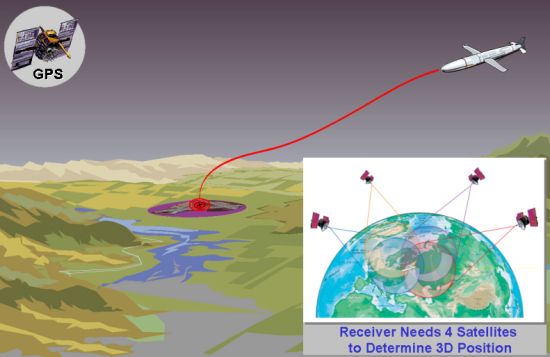
The advent of the global positions system (GPS) has largely replaced radio beacons in both military and civilian use. GPS consists of a constellation of 24 satellites in geosynchronous orbit around the Earth. If a GPS receiver on the surface of the Earth can receive signals from at least four of these satellites, it can calculate an exact three-dimensional position with great accuracy. Missiles like JSOW and the JDAM series of guided bombs make use of GPS signals to determine where they are with respect to the locations of their targets. Over the course of its flight, the weapon uses this information to send commands to control surfaces and adjust its trajectory.
Celestial Navigation Guidance
Celestial navigation is one of the earliest forms of navigation devised by humans. and it saw its greatest application in the voyages of the great maritime explorers like Christopher Columbus. Celestial navigation uses the positions of the stars to determine location, especially latitude, on the surface of the Earth. This form of navigation requires good visibility of the stars, so it is only useful at night or at very high altitude. As a result, celestial navigation is seldom applied to missiles, though it has been used on many ballistic missiles like Poseidon. The missile compares the positions of the stars to an image stored in memory to determine its flight path.
Geophysical Navigation Guidance
Perhaps even older than celestial navigation is geophysical navigation, which relies on measurements of the Earth for navigation information. Methods that fall under this category include the use of compasses and magnetometers to measure the Earth's magnetic field as well as gravitometers to measure the Earth's gravitational field.
While these methods have not found much application in missiles, a more useful technique is terrain matching. This method typically requires a radar altimeter that uses radar waves to determine height above the ground. By comparing the contours of the terrain against data stored aboard the missile, the autopilot can navigate its way to a particular location.
A related but more accurate technique is called digital scene matching. In concept, digital scene matching is little different than looking out the window of your car and using landmarks to navigate your way to a specific location. Missiles make use of this technique by comparing the image seen below the weapon to satellite or aerial photos stored in the missile computer. If the scenes do not match, the computer sends commands to control surfaces to adjust the missile's course until the images agree. Digital scene matching is used on the Tomahwak cruise missile.
Summary
As discussed earlier, a missile may use one particular form of guidance throughout its flight or it may depend on
different types of guidance at different times. Many weapons also make use of a combination of methods
simultaneously. In particular, a common technique is a combined GPS/INS system that takes advantage of both
inertial and ranging guidance to improve accuracy.
- answer by Jeff Scott, 1 August 2004
Related Topics:
Read More Articles:


|
Aircraft | Design | Ask Us | Shop | Search |

|
|
| About Us | Contact Us | Copyright © 1997- | |||
|
|
|||